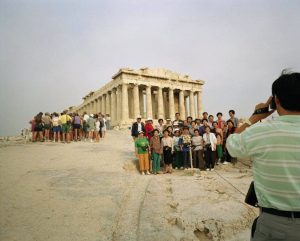“Acropolis Now”
The Economist magazine (April 29, 2010), referring ironically to the Greek financial situation
Today the Acropolis, splendidly restored and partially reconstructed, is a must-see destination for any tourist visiting Europe. Freewheeling back-packers and package-deal tourist groups alike alight on the “Sacred Rock” to experience firsthand the Periclean monuments. While some may merely check it off their “to do” lists, most are profoundly touched by the spectacle of history, gleaming marble, blue sky, and brilliant light.
As with other tourist destinations, crowd control at the Acropolis has become a major enterprise. Especially during the summer months visitors are expeditiously kept on designated pathways. Entering any of the ancient structures is now severely restricted, as are the nighttime full-moon visits of yore. In 2000, before the 2004 Athens Olympics, the Acropolis museum was moved to a new and much larger site nearby.
As a whole, the Acropolis does more than bear testimony to the greatness of Periklean Athens of the fifth century BCE. It has become the iconic monument associated with Greece as a modern nation state. On a loftier level, it marks the birthplace of Western civilization and serves as the global symbol of democracy. Thus the Acropolis continues to inspire.

(PA)
Martin Parr (British, born 1951)
Greece, Athens, Acropolis, 1991, from the series Small World
Gift (by exchange) of Wilson Farnsworth, George Mead, and Henry Sheldon
2015.226
I became interested in the disconnect between the mythology of places […] and the reality of being there, jostling with hundreds of other tourists trying to get a clear shot.
Martin Parr, on tourism.
